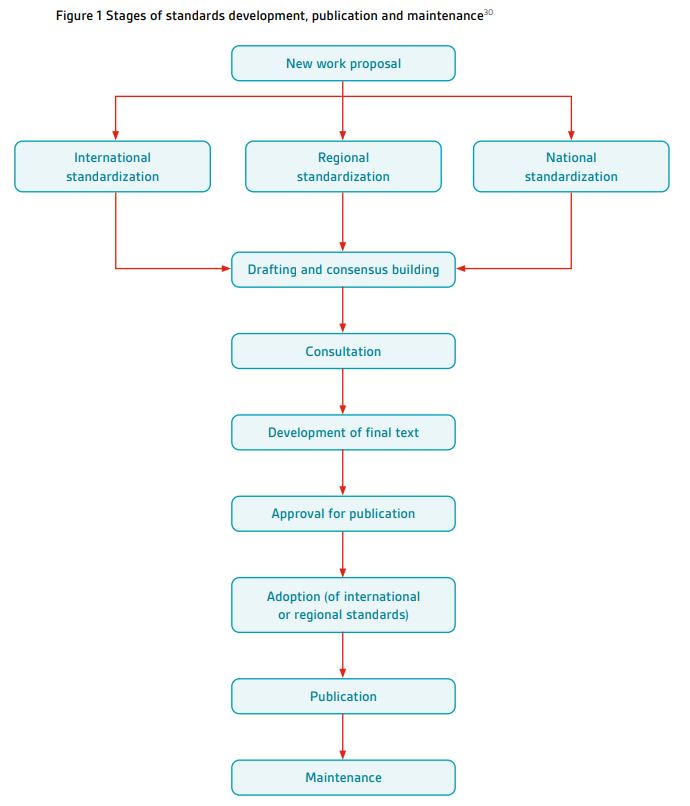Development of standards

Standards are used to support the regulatory process because they are developed in accordance with set principles of transparency, openness to participation by interested stakeholders, balance of representation and due process. The way that standards are developed is intended to assure that, while many interests are considered, no single party wields disproportionate influence.
The process and description of stages in the development of standards can differ between SDOs. Figure 1 gives a general description of the common elements involved.

The process for developing a standard starts with a proposal for new work. This gives the intended scope and purpose of the standardization project. The proposal is subject to review to determine if the proposed project is feasible and should go ahead.
Whether the standard is developed at an international, a regional or a national level, approved projects go through a process of drafting and building a consensus on the technical content. This can take place in a variety of different settings such as project teams, task groups, working groups, subcommittees or committees. When the group has reached an agreement, there is a period of consultation when the text is made widely available for comment from stakeholders. All these inputs are considered and there can be several consultations on iterations of the draft as it evolves. After consultation, the inputs are addressed and the final text developed. This text generally goes through an approval process, such as a ballot. However, in some cases if the requirements for consensus are met during the consultation stage, the approval stage may be omitted.
Standards developed internationally or regionally go through a process to be adopted as national standards. Members of the European Standards organizations, such as the UK, are obliged to adopt and publish European Standards without change when they are approved.
For standards listed in the EU standardization request (see 3.2), the European foreword and Annex Z that describe the relationship between the standard and the European regulatory requirements are developed at the same time as the standard. These parts of the standard go through the development process, and associated consensus building, as the text of the standard itself. There are specific additional reviews, however, where the foreword and Annex Z are considered by consultants engaged on behalf of the European Commission. A consultant is assigned to assess the standard, European foreword and Annex Z against criteria set by the European Commission, to provide comments and recommendation on the suitability of the standard to support the regulatory requirements. These assessments can take place at the working draft stage but are most important at the consultation and approval for publication stages. When any comments from the consultants are addressed by the standards drafters, the European standard, or European adoption of an international standard, can be published with the European foreword and Annex Z included. On publication, the standard is proposed to the European Commission for inclusion in the list of harmonized standards. The final decision on whether to cite the standard in the Official Journal rests with the European Commission. There have been instances when, even if the consultant has given a positive assessment, the European Commission has not accepted some standards for citation. That stage of review by the European Commission only occurs once the standard has been published, which means that to correct this, the standard has to be subsequently amended or revised.
Unfortunately, the process of resolving comments from the consultants has, in some instances, led to:
- delays in the publication of international standards
- delays in adoption of international standards as European standards or
- formally de-linking the standard from the European legislation and adoption of international standards as European standards without the inclusion of required information in the European foreword or Annex Z, making the standard unsuitable for harmonization under the MDR or IVDR
Hopefully, with the successful publication of the first lists of harmonized standards for the MDR and IVDR establishing precedents for the process, such delays or disconnections between international and European standards can be avoided in future.
Following citation of a standard in the Official Journal, a formal objection can be raised against the citation if the standard is considered not to support European legislation adequately.[31] Updates to the lists of harmonized standards in the Official Journal are made periodically.
Published standards have established processes to make sure that they remain current. Revisions can be triggered by identification of a specific need, such as a change in technology, the state of the art, user needs and expectations or regulatory requirements. Standards are also reviewed on a set frequency – generally the default is a 5-year interval of systematic review. The outcome of the systematic review can be that the standard is confirmed without change, identified for revision or withdrawn.
Participating actively in the development of standards is a timeconsuming process. Organizations nominating individuals to undertake standards development activities need to be aware of the time that needs to be allocated and be prepared to dedicate that level of resource. The precise amount of time that is needed will vary at different stages of the development process. Not only it is necessary to review text and prepare comments, but also to prepare text for working drafts and to support comments. Comments from other stakeholders need to be reviewed and addressed. Participating in standards development is a significant commitment and a strategic decision of a nominating organization. Participating in the standards development process can provide organizations with information on the rationale behind the requirements and that insight provides some element of competitive advantage.
[30] Adapted from BS 0:2021, A standard for standards — Principles of standardization [31] Article 11 of Regulation 1025/2012 of the European Parliament and of the Council of 25 October 2012 on European standardisation, amending Council Directives 89/686/EEC and 93/15/EEC and Directives 94/9/EC, 94/25/EC, 95/16/EC, 97/23/EC, 98/34/EC, 2004/22/EC, 2007/23/EC, 2009/23/EC and 2009/105/EC of the European Parliament and of the Council and repealing Council Decision 87/95/EEC and Decision No 1673/2006/EC of the European Parliament and of the Council Text with EEA relevance
This blog post is an excerpt from our latest whitepaper: Using Standards to Demonstrate Conformity. Please download the full whitepaper to find out more information.
The Compliance Navigator blog is issued for information only. It does not constitute an official or agreed position of BSI Standards Ltd or of the BSI Notified Body. The views expressed are entirely those of the authors.

